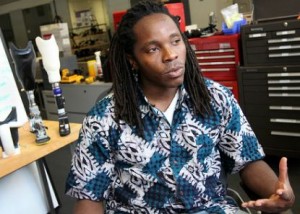Through Research and Innovation, Alum Gives Back to Sierra Leone
-
-
slice.mit.edu
Filed Under
Recommended

When the African country of Sierra Leone’s civil war ended in 2002, an estimated 10,000 Sierra Leoneans were amputees, the result of a common tactic used to instill fear during the 11-year war.
Although David Sengeh SM ’12, a Sierra Leone native and Media Lab doctoral candidate, escaped the war physically unharmed, he is dedicating his professional life to helping move his home country forward after years of warfare.
In recent months, Sengeh has been highlighted by CNN, Fast Company, and MIT News for his work on behalf of Sierra Leone, both for amputees and the general population.
On CNN’s African Voices, Sengeh was profiled for his research in the Media Lab’s Biomechatronics Group, where he is developing custom-fitting prosthetic limbs by merging MRI scans with 3D computing technology. In the years following the war, Sengeh realized that many amputees in Sierra Leone chose not to wear prostheses because of the discomfort they caused.
From “Civil war survivor creates 'perfect fit' bionic limbs,” CNN African Voices:“We are getting images, we are getting data that quantifies your body's impedance, stiffness, (and) how stiff each point is...We can use that with the surface information that we have, and modeling that we do, to create you a perfect shape and a multi-material impedance prosthetic socket.”

In a June 2013 article in Fast Company, Sengeh was lauded for creating the Human Bionic Project, a research tool that tracks the progress of new innovations in prostheses-related research. Sengeh developed the project, which he calls an interactive online repository of FDA-approved prostheses, alongside a team of MIT researchers.
From “The Human Bionic Project: A Data Repository for Inspector Gadget Body Parts,” Fast Company:Earlier this year, MIT News featured Sengeh for his work on Innovate Salone, a non-profit innovation competition aimed at Sierra Leone high school students. More than 300 students entered the competition and participated in more than 70 projects. Eight finalists received $500 dollars, including 15-year old Kelvin Doe, who built a homemade FM transmitter to relay local news. A video of Doe’s story went viral and he late visited MIT and Harvard.“So far, the Human Bionic Project has between 40 and 50 points of reference on its corporeal map--everything from artificial hearts to bionic jaws. In addition to photos and descriptions, the team will soon be looking to source videos of prosthetics in action from the public.”
From “Graduate student David Sengeh gives back to Sierra Leone,” MIT News:Learn more about Sengeh’s research, the Biomechatronics Group, and Innovate Salone.“Sengeh’s strongest impulse remains the desire to empower people to find their own solutions. That sense of putting power into people’s hands is reflected in Innovate Salone’s slogan: ‘We all de mek am,’ which translates as, ‘We are all the makers.’"







